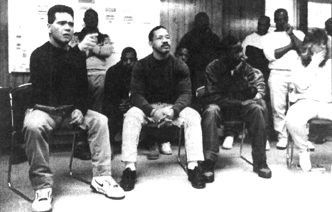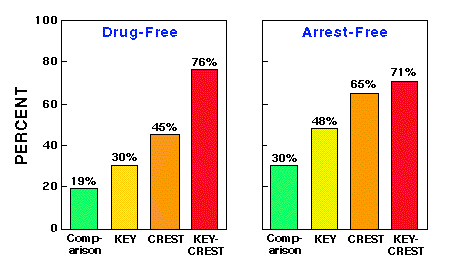A NIDA-funded treatment research program is showing that prison can be a place to begin the rehabilitation of offenders with a history of drug abuse and help them make the changes necessary to become law-abiding members of society.
Early findings from the study indicate that drug-involved inmates who participate in a multistage treatment program that begins in prison and continues in a transitional facility called a work release center can significantly reduce their drug abuse and rearrest rates. In both prison and the work release center, program participants live in a therapeutic community where they learn to help themselves and other residents change negative patterns of thinking and acting that are thought to underlie drug abuse.
 In group therapy sessions, such as the one picture here, residents in the CREST work release therapeutic community learn to take responsibility for their actions, shed the negative patterns of thinking, feeling and behaving that contributed to their drug use, and acquire positive social attitudes and behaviors that can help them achieve a responsible, drug-free lifestyle.
In group therapy sessions, such as the one picture here, residents in the CREST work release therapeutic community learn to take responsibility for their actions, shed the negative patterns of thinking, feeling and behaving that contributed to their drug use, and acquire positive social attitudes and behaviors that can help them achieve a responsible, drug-free lifestyle.Although therapeutic community drug abuse treatment in prison is not new, previous programs did not have a work release component, points out Dr. Peter Delany of NIDA's Services Research Branch. The work release component has a significant impact on the relapse and recidivism rates of the offenders involved in this study, he says. In fact, the study's preliminary results suggest that the work release therapeutic community, which links treatment in prison with followup treatment in the community, may be the most influential part of the treatment program, he says.
The program, which was implemented by Dr. James A. Inciardi of the University of Delaware in the Delaware correctional system, consists of three phases. In phase one, offenders live for 12 months in a therapeutic community in prison, called the KEY; in phase two, they spend another 6 months in a therapeutic community, called CREST Outreach Center, which is a work release facility; and in phase three, they participate in counseling and group therapy for an additional 6 months after they leave work release and while they are on parole or other supervised release.
Because drug use, violence, and negative attitudes about drug abuse treatment pervade prisons and work release centers and make rehabilitation difficult, the program separates KEY and CREST participants from the rest of the correctional population. This separation enables residents to create an atmosphere that encourages them to help themselves and each other as they go about their day-to-day jobs, meetings, and recreational and social activities. In this environment, clients gradually learn to take responsibility for their actions, shed the negative patterns of thinking, feeling, and behaving that contributed to their drug use, and acquire positive social attitudes and behaviors that can help them achieve a responsible, drug-free lifestyle.
In the initial evaluation of the program, Dr. Inciardi and Steven S. Martin looked at drug use and re-arrest rates among 457 drug-involved offenders 6 months after their release from prison. The researchers compared reported drug use and rearrest rates among offenders who had participated in KEY only, in CREST only, in both KEY and CREST, or in neither phase of the program.
 Delaware Multistage Correctional Treatment Program - 18 Months After Release from Prison. When researchers compared reported drug use and rearrest rates among offenders who had participated in KEY only, in CREST only, in both CREST and KEY, or in neither phase of the program, they found that KEY and CREST participants show strongly positive effects of treatment 18 months after their release from prison.
Delaware Multistage Correctional Treatment Program - 18 Months After Release from Prison. When researchers compared reported drug use and rearrest rates among offenders who had participated in KEY only, in CREST only, in both CREST and KEY, or in neither phase of the program, they found that KEY and CREST participants show strongly positive effects of treatment 18 months after their release from prison.Comparison: No Treatment
KEY: In prison therapeutic community only
CREST: Work release therapeutic community only
KEY-CREST: Both therapeutic communities
Results are adjusted to account for gender, race, age, criminal history, previous drug use, and followup time.
After controlling for client variables such as age, previous drug abuse treatment, and criminal history that could affect treatment outcomes, the researchers found that clients who had participated in both KEY and CREST were most likely to be drug and arrest free. Specifically, 95 percent of these inmates were drug free and 97 percent were arrest free. By comparison, 35 percent of the group that had received no treatment were drug free and 62 percent were arrest free.
A recent analysis of followup data on a subset of 206 drug-involved offenders indicates that KEY and CREST participants still show strongly positive effects of treatment 18 months after their release from prison. This analysis shows that 76 percent of clients who had participated in both KEY and CREST were still drug free and 71 percent were arrest free 1 year after completing work release. In marked contrast, only 19 percent of the group that received no treatment were drug free and 30 percent were arrest free at the 18-month evaluation.
Breaking the 18-month results down further to examine the effectiveness of each treatment phase, the researchers found that KEY-only participants who had no subsequent treatment did only slightly better than the no-treatment group: 30 percent remained drug free and 48 percent arrest free. However, CREST-only graduates who had received no prior treatment in KEY showed a significant treatment effect: 45 percent were drug free and 65 percent arrest free.
Clients in the KEY-only group who had gone to a regular correctional work release center instead of CREST did not do significantly better than the no-treatment group because they did not receive followup care, says Dr. Inciardi. While the need for aftercare is not new in the drug abuse treatment field, this finding underlines the fact that "unless you have that followup care in the community, you've wasted your money," Dr. Inciardi says.
Although the early data also suggest that CREST by itself yields significant results, these results are not as good as those achieved by KEY and CREST together. Simply providing a work release therapeutic community for offenders without prior treatment in prison is not likely to be effective in the long run, says Dr. Inciardi.
"We're not really going to see the major differences in the relative effectiveness of KEY, CREST, and KEY-CREST and the aftercare component until all the long-term followup evaluation is completed," he says. That evaluation and subsequent assessments conducted 42 and 54 months after inmates are released from prison will determine the effects of all three stages of the treatment program, he says. Because a key variable related to success in treatment is length of stay, Dr. Inciardi says he expects that offenders who participate in the entire spectrum of treatment, from prison to the community, will benefit the most.
Sources
- Inciardi, J.A. An Effective Continuum of Corrections Based Treatment. Paper presented at National Institute of Justice Research Symposium, Washington, DC, 1995.
- Inciardi, J.A.; Lockwood, D.; and Hooper, RM. Through therapy: Delaware treatment program presents promising results. Corrections Today 56(1):34-42, 1994.
- Martin, S.S.; Butzin, C.A.; and Inciardi, J.A. Assessment of a multistage therapeutic community for drug involved offenders. The Journal of Psychoactive Drugs, in press.
